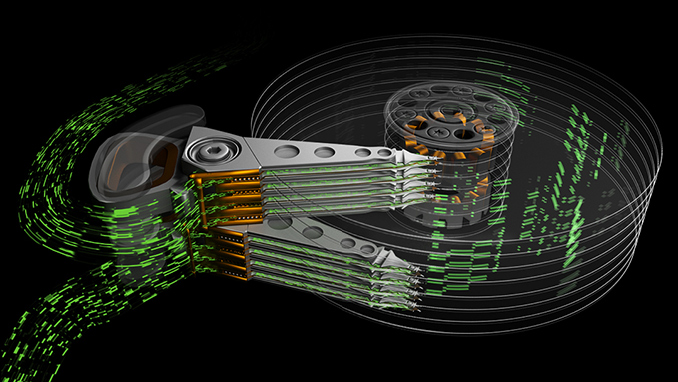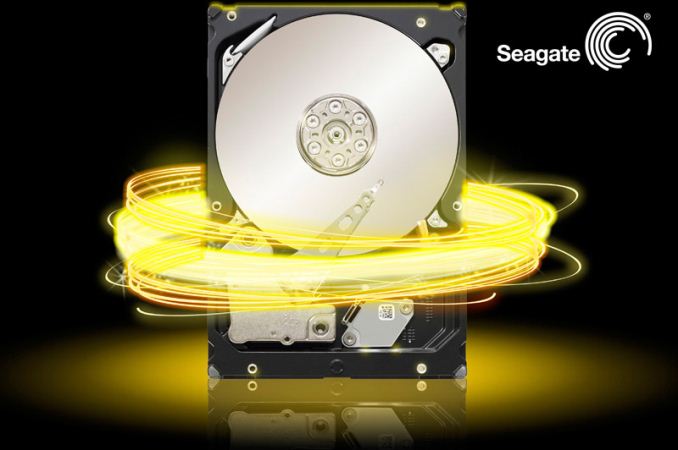Seagate’s Multi Actuator Technology to Address HDD IOPS Woes
by Anton Shilov on December 29, 2017 12:01 PM EST
Seagate introduced its new Multi-Actuator Technology (MAT) for hard drives earlier this month. It promises to increase hard drive performance by using two or more sets of actuator arms that operate independently from a single pivot point. Seagate claims that next-gen HDDs will require higher performance to effectively take advantage of their increased capacities. It plans to use MAT in their datacenter hard drives going into pilot production in 2018.
To improve the performance of next-generation hard drives, Seagate proposes to install not one, but two (or more) sets of actuators into a single HDD. The actuators are to be equipped with their own arms/heads as well as magnets to position them, but will use one pivot. As a result, the actuators will be able to act completely independently, essentially creating parallelism within a single hard drive. With an architecture like this, IOPS performance will scale with the number of actuators. Aggregate read/write performance of hard drives will also increase, but since it will depend on many factors, it is too early to make predictions regarding throughput of next-gen HDDs. The additional components required for two independent actuator assemblies (and a considerably more sophisticated HDD controller) will make such hard drives more expensive to build when compared to today’s models. This could be one of the reasons why Seagate plans to use its Multi-Actuator Technology only for hard drives designed for datacentres, where hardware costs are not as crucial as performance and features.
The first-generation MAT-enabled HDDs are to use two actuators operating on a single pivot point (along with 8 platters and 16 heads), but going forward the number of actuators may grow. Seagate says that the host computer can “treat a single Dual Actuator drive as if it were two separate drives”, but stresses that logically the HDD will remain a single device with two access streams for communication, just like dual-port SAS drives do. Meanwhile, Dual Actuator HDDs will be able to use not only SAS, but also NVMe and SATA interfaces. In the best-case scenario, a hard drive with two actuators can double the random read/write performance and almost double the sequential read/write performance compared to today's hard drives. The sequential access case is a bit tricky, since the cylinder height gets halved with two actuators, and a lot depends on how the addresses are translated to the actual physical sectors.
The arrival of new magnetic recording technologies in the coming years will significantly increase capacities of hard drives for cloud/exascale datacenters to over 20 TB by 2020 and to 40 TB within the next five or seven years. The upcoming HDDs will increase their sequential read/write performance along with the increase of their areal densities, but when it comes to latencies and random read and write operations, things get more complicated. The current HDD architecture uses a single actuator that synchronously moves all the arms with read-write heads over the media together for reading and writing data. With such an architecture, the platters can only work on one request at a time. Meanwhile, the more data an HDD stores, the more requests it gets and the more time it spends seeking the right track/sector. If/when fulfilling a request takes too long, quality of service (a metric dear to datacenter operators) suffers. Today, the performance bottleneck is solved by using either NAND flash or multiple hard drives in parallel, effectively combining their performance for certain access traces. At some point, this approach may become inefficient due to power/complexity and other factors. Therefore, it is imperative that HDDs get faster in order to cope with tomorrow’s workloads.
Seagate says that the Multi-Actuator Technology is to be deployed on products in the near future, but does not disclose when exactly. As the company’s blog post on the matter mentions both MAT and HAMR, it is highly likely that commercial hard drives featuring HAMR due in late 2019 will also have two actuators on a single pivot. At the same time, it does not mean that the MAT is not going to find itself a place in products using conventional PMR.
Related Reading
- Western Digital Stuns Storage Industry with MAMR Breakthrough for Next-Gen HDDs
- Toshiba Announces 14 TB PMR MG07ACA HDD: 9 Platters, Helium-Filled, 260 MB/s
- Toshiba Commercializes SDK’s 9th Gen PMR, Tech Enables 14 TB PMR HDDs in 2018
- Western Digital Now Shipping 14 TB HDDs: HGST Ultrastar Hs14 with 1000 Gb/in2
- Western Digital Announces Ultrastar He12 12 TB and 14 TB HDDs
- Seagate Announces Enterprise Capacity 12 TB HDD: 2nd-Gen Helium-Filled Hard Drives
Source: Seagate











88 Comments
View All Comments
Pixels303 - Friday, December 29, 2017 - link
You need to remember, eight heads reading one sector reads eight times the information in one movement, whereas four heads moving reads four times the information in one movement. This may decrease latency, the read speeds will decrease by the multiple of actuator splits. This technique of splitting actuators is nothing more than a gimmick. Only way to decrease latency is by decreasing the mass of the arms or increasing the rotational speed of the platters. Ever think of using graphine for the coils and carbon nanotube for the arms? Should be vastly lighter then.. Hard drive manufacturers already have technology that could improve products, but do not use intentionally to safeguard long term business strategies. If you knew you could sell sour milk for the same price as fresh milk, would you bother to try getting milk out faster? Seagate is lazy.cjl - Friday, December 29, 2017 - link
Hard drives do not read all heads in parallel - they read one head at a time. Therefore, your argument is incorrect - read speeds are independent of the number of platters/heads in a drive, they only depend on linear data density (kfci) and RPM, and this drive should (in theory) be able to stream data at twice the rate of a single-actuator drive that is otherwise identical.mode_13h - Friday, December 29, 2017 - link
Source? Why on earth wouldn't they stripe clusters across platters, or at least put consecutive clusters on adjacent platters? That's just dumb.cjl - Friday, December 29, 2017 - link
Because the tracks are so small that you can't guarantee that all the heads are on track at once. Slight thermal variations up and down the head stack will skew it by several tracks, vibrations will not affect all the heads equally, and tracks on adjacent disks won't even be perfectly concentric (though they're pretty close). As a result, you can't read from multiple heads simultaneously because you can't keep both of them perfectly centered on each track. Multiple independent actuators solves this, which is why this drive should be able to double sequential performance.Now, they do put consecutive data on adjacent platters, so a sequential read will actually (on the disk) read some data from one surface, then jump to the next surface, etc, so the overall drive goes smoothly from outside to inside as you go from the start to the end of the data. You just have to read each surface consecutively rather than concurrently.
mode_13h - Friday, December 29, 2017 - link
I'm pretty sure I read sometime in the past 10 years that the tracks are actually created by the heads (during a low-level format?). If true, that should avoid some of the variation you mention. That said, I get that there might be some variation in the arm geometry over time and as the drive heats up, etc. It's just unfortunate they can't exploit that additional parallelism.I read about WDC drives with dual-stage actuators, in about 2010. Would be interesting if the second stage was per-platter to enable concurrent reading/writing.
https://techreport.com/review/17812/western-digita...
https://www.hgst.com/sites/default/files/resources...
cjl - Friday, December 29, 2017 - link
I believe WD/Hitachi is doing self servo write, but Seagate is still using MDWs (multi disc writers) to write their servo pattern before the disc stack is assembled. Regardless though, even if the stack is aligned in one configuration, it will tiltscjl - Friday, December 29, 2017 - link
Unfortunately, I can't edit after fat fingering my last post, but to continue...I believe WD/Hitachi is doing self servo write, but Seagate is still using MDWs (multi disc writers) to write their servo pattern before the disc stack is assembled. Regardless though, even if the stack is aligned in one configuration, it will still go out of alignment due to thermal expansion, different impacts from vibration, etc. Dual stage actuators don't fix this either - they just allow higher bandwidth and smaller track pitch. As far as I know, every hard drive in production today uses just one read/write head at a time when transferring data.
mode_13h - Friday, December 29, 2017 - link
Since each actuator is driving 1/N the number of arms & heads, why wouldn't the mass decrease to nearly 1/N?Also, the time to read a cluster only matters if reads/writes are large. Since they explicitly care about IOPS, presumably the accesses are mostly small, in which case it's dominated by seek time, which benefits from not only parallelizing the accesses but also decreasing the mass of the arms & heads.
cjl - Friday, December 29, 2017 - link
I would tend to expect seek time to be pretty much the same for this drive as for a single actuator, since the lower inertia of the actuator will be offset by the lower torque constant of the thinner voice coil motor. This will be great for higher-queue IOPS though, since you can be servicing two requests simultaneously.prime2515103 - Friday, December 29, 2017 - link
They stole my idea! I thought of this back in the '90's. Geez...